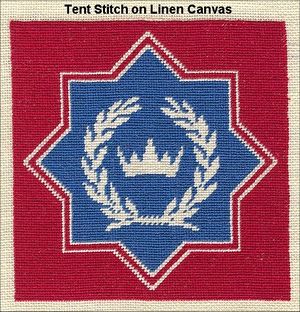Tent stitch: Difference between revisions
From Cunnan
Jump to navigationJump to search
m (fixing self-link) |
m (image format) |
||
| Line 1: | Line 1: | ||
| ⚫ | |||
'''Tent stitch''' was a popular and easy to work [[embroidery]] stitch used extensively for creating richly decorated furnishings. |
'''Tent stitch''' was a popular and easy to work [[embroidery]] stitch used extensively for creating richly decorated furnishings. |
||
| Line 8: | Line 9: | ||
=== External Links === |
=== External Links === |
||
* How to do Tent Stitch - http://www.needlepoint.org/StitchOfTheMonth/98-02.htm |
* How to do Tent Stitch - http://www.needlepoint.org/StitchOfTheMonth/98-02.htm |
||
| ⚫ | |||
Revision as of 16:06, 29 March 2004
Tent stitch was a popular and easy to work embroidery stitch used extensively for creating richly decorated furnishings.
There were two main techniques:
- The first was made using tent stitch, silk thread and linen ground. The pattern was drawn on the ground and it was then embroidered using coloured silk threads. The whole of the linen ground was covered in stitching. This technique was used extensively for furnishings such as table carpets, cushions and bed valances.
- The second technique was the making of slips. A famous example of these are the Oxburgh Hangings, partly worked by Mary, Queen of Scots. The Oxburgh Hangings were produced by making slips and applying these to a velvet ground.
External Links
- How to do Tent Stitch - http://www.needlepoint.org/StitchOfTheMonth/98-02.htm
